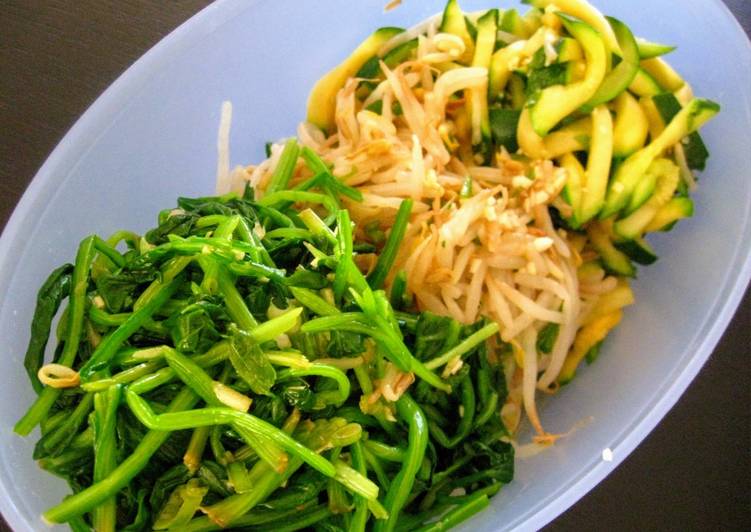
Hey everyone, I hope you are having an incredible day today. Today, I will show you a way to prepare a distinctive dish, basic namul banchan (korean sesame-garlic vegetable side dish). One of my favorites food recipes. This time, I will make it a bit tasty. This will be really delicious.
Basic Namul Banchan (Korean Sesame-Garlic Vegetable Side Dish) is one of the most favored of recent trending meals in the world. It is appreciated by millions daily. It’s easy, it is fast, it tastes delicious. They’re fine and they look fantastic. Basic Namul Banchan (Korean Sesame-Garlic Vegetable Side Dish) is something that I have loved my whole life.
Great recipe for Basic Namul Banchan (Korean Sesame-Garlic Vegetable Side Dish). Namul (NAHmool) in banchan speak typically refers to vegetable matter made in more of a fresh (not necessarily raw, but as opposed to pickled or preserved) preparation, and often using leafy greens and sprouts. With that in mind, it's easy to see why whipping up a Korean menu can seem like a daunting task if you're in a hurry or pressed for time.
To get started with this particular recipe, we have to prepare a few ingredients. You can cook basic namul banchan (korean sesame-garlic vegetable side dish) using 11 ingredients and 10 steps. Here is how you can achieve it.
The ingredients needed to make Basic Namul Banchan (Korean Sesame-Garlic Vegetable Side Dish):
- Prepare Vegetables of your choosing (see above) - at least 3/4 pound of each kind
- Make ready water
- Take salt
- Prepare Seasoning:
- Make ready 1 small clove garlic, minced (about 2/3 teaspoon)
- Make ready 1/2 green onion, finely chopped
- Get 1/2 teaspoon kosher salt (if you're using table salt, use roughly 90% the amount) OR 1.5 Tablespoons light soy sauce
- Get 1/2 teaspoon sugar
- Prepare 1 teaspoon toasted sesame oil
- Make ready 1/2 teaspoon neutral oil
- Make ready toasted sesame seeds for garnish (nice to have, not a biggie if you don't)
They're served with just about every meal, and they're meant to be shared with everyone eating. They may seem insignificant at first glance compared to the rest of the meal, but they're packed with flavor. In its basic form, boribap is a South Korean dish consisting of steamed rice and barley that are served with doenjang stew (fermented soybean) and a variety of side dishes (banchan). The dishes served with boribap are typically vegetarian and may include various greens and vegetables (namul), and they are usually topped with gochujang chili.
Steps to make Basic Namul Banchan (Korean Sesame-Garlic Vegetable Side Dish):
- Bring about 6 cups of water plus 2 teaspoons of salt to a gentle boil. After you put the water on the stove, prepare an ice bath in a large mixing bowl to shock the vegetables after they've been blanched.
- Prepare your vegetables for blanching. Leafy greens always benefit from a good bath in water to release all the dirt and sand accumulated in the growing process. Spinach can be particularly dirty, especially after a good rain, so make sure to wash the spinach as many times as it takes for your water to run clean. Sprouts don't usually need to be washed.
- When the water is gently boiling, place your first batch of vegetables in the water. Contrary to popular wisdom, I actually have had no problems putting as much vegetable matter into the pot as the water will cover.
- Blanch the vegetables until the leafy parts turn a brighter, deeper green and the stalks just turn translucent (or in the case of sprouts, until they just turn translucent), no more than 2 or 3 minutes. If you're making spinach, take it out of the water immediately after it starts to wilt, which is probably no more than 30 seconds.
- Take the vegetables out of the boiling water, place them immediately in the ice water bath and give them a good swish, letting them shock (essentially stop cooking) and cool for 3 or 4 minutes before removing them to a strainer/colander. You'll want to throw out some of the water and add more ice to keep the shocking water cold.
- Repeat steps 3 to 5 for the rest of the vegetables and strain in the colander.
- In fist sized batches, and according to type, thoroughly squeeze the excess liquid from the vegetables. This takes 2 or 3 squeezes and is an important step to keep from diluting the seasoning.
- Cut into bite sized pieces (1 to 1.5 inches in length), but not the sprouts. We rarely ever cut the sprouts.
- For every 2 cups of prepared vegetables, add the seasonings listed above and toss to season thoroughly and evenly.
- Enjoy as a side dish with your Korean meal, by itself as a snack, or use it to make a yummy bowl of bibimbap! :)
Bring a large pot of water to a boil. Strain them and rinse in cold water in a large bowl for a couple of times. Today, we'll be making some easy Korean side dishes for samgyupsal and Korean BBQ! We'll show you how to make easy korean side dishes. Basic Namul Banchan (Korean Sesame-Garlic Vegetable Side Dish) Namul (NAHmool) in banchan speak typically refers to vegetable matter made in more of a fresh (not necessarily raw, but as opposed to pickled or preserved) preparation, and often using leafy greens and sprouts.
So that is going to wrap it up with this special food basic namul banchan (korean sesame-garlic vegetable side dish) recipe. Thanks so much for your time. I am sure you can make this at home. There’s gonna be more interesting food at home recipes coming up. Don’t forget to save this page on your browser, and share it to your loved ones, friends and colleague. Thank you for reading. Go on get cooking!


